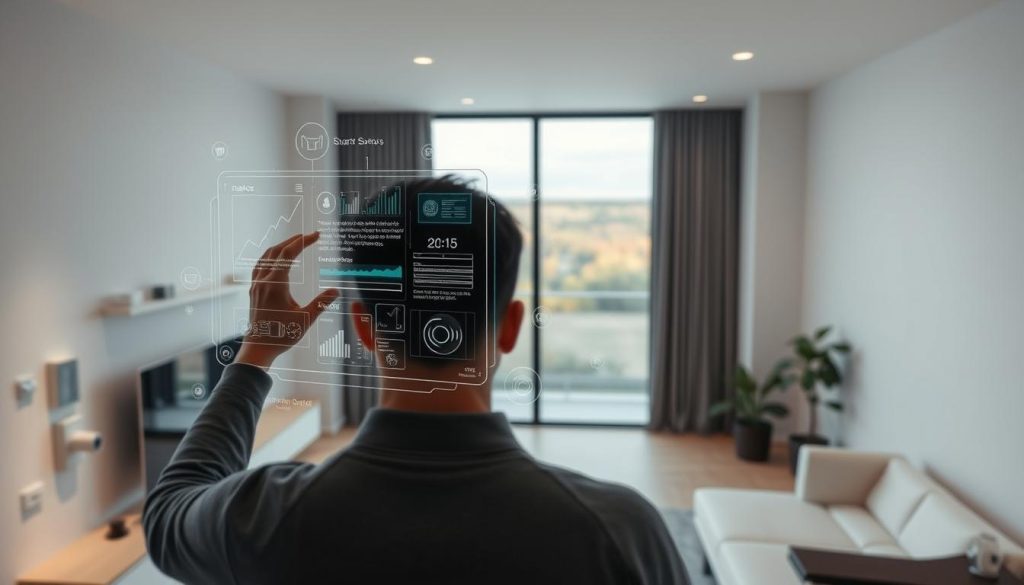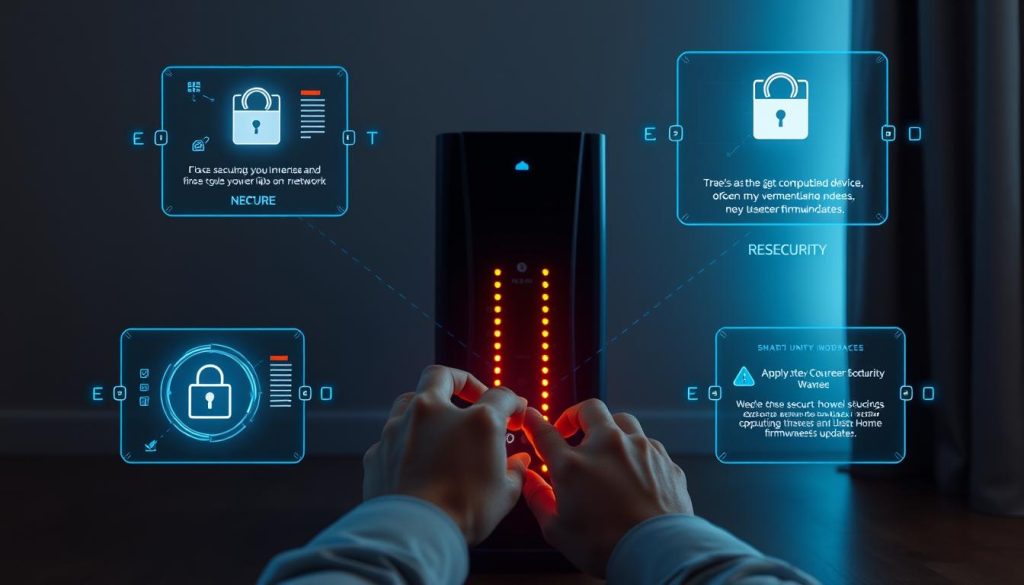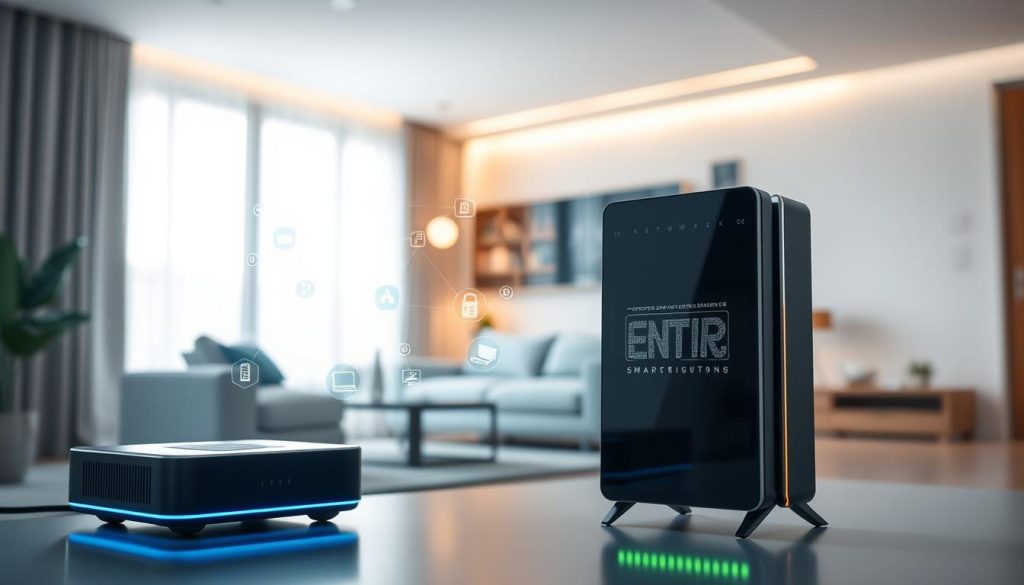You’re using more smart home devices to make life easier. But, this ease raises big privacy concerns. With more smart homes, edge computing is changing how these devices work.
Edge computing handles data near where it’s made, cutting down on delays and boosting performance. Yet, it also brings up big questions about data security and who sees your personal info. It’s key to know the privacy implications of edge computing in smart homes to keep your data safe.
Key Takeaways
- Edge computing is changing the smart home landscape.
- Data security is a major concern with edge computing.
- You need to understand who has access to your personal data.
- Effective privacy measures are necessary to secure your data.
- Smart home devices require careful consideration of privacy implications.
Understanding Edge Computing in Smart Homes
Exploring smart homes means learning about edge computing. This technology processes data near its source. It cuts down on delays and makes decisions faster. In smart homes, many devices create lots of data.
What is Edge Computing?
Edge computing is about processing data near its source. It reduces the time it takes for data to reach a central server. This makes data analysis quicker and more efficient.
Key benefits of edge computing include:
- Reduced latency
- Improved real-time decision-making
- Enhanced data privacy and security
How Does It Work in Smart Homes?
In smart homes, edge computing devices handle data locally. This means they don’t always need to talk to the cloud. It’s great for things that need to act fast, like security systems.
For example, a smart security camera can check video feeds itself. It can spot and act on threats right away, without sending data to the cloud.
The Rise of Smart Homes
Technology keeps getting better, and smart homes are becoming more common. They offer a more convenient and connected lifestyle. Now, you can easily control and monitor your home with smart devices.
Popular Smart Home Devices
Smart home devices are getting more popular. There are many options to fit different needs. Some top devices include:
- Smart thermostats, like Nest, that learn your temperature preferences and adjust.
- Smart security cameras, such as Ring, for remote home monitoring.
- Smart speakers, including Amazon Echo and Google Home, for voice control.
- Smart lighting systems, like Philips Hue, for energy-efficient control.
Benefits of Smart Homes
Smart homes offer many benefits, making them appealing to homeowners. Key advantages include:
- Increased Convenience: Control your home remotely, making daily life easier.
- Energy Efficiency: Devices like smart thermostats and lighting systems save energy and lower bills.
- Enhanced Security: Smart cameras and doorbells add security, letting you monitor your home and get alerts.
Smart home technology makes your living space more comfortable, convenient, and secure. As this trend grows, it’s crucial to focus on Smart Home Data Security and Smart Home Privacy Best Practices. This ensures your smart home stays safe and private.
Privacy Concerns with Smart Home Technology
Smart home devices are convenient but raise big privacy worries. As you add more devices, your home network becomes a target for privacy threats.
These devices collect a lot of data, like your habits and even voice recordings. This raises big questions about how your data is used and kept safe.
Data Collection and Usage
Smart devices collect data to work better and serve you better. But, this data can also be used in ways that might hurt your privacy. For example, voice assistants like Alexa or Google Assistant record your voice commands. They can build a detailed picture of your life.
Types of Data Collected:
- Voice commands and recordings
- Usage patterns and habits
- Location data and device information
It’s key to know how your data is collected, stored, and used. Check the privacy policies of your device makers to understand how they handle your data.
Risks of Data Breaches
Smart home tech is also at risk of data breaches. When your devices are online, hackers can find ways in. A breach could leak your personal info or use it wrongly.
The dangers of data breaches in smart homes are many:
| Risk | Description | Potential Impact |
|---|---|---|
| Unauthorized Access | Hackers gaining access to your devices and data | Exposure of personal information |
| Data Theft | Stolen data being used for malicious purposes | Financial loss, identity theft |
| Device Manipulation | Hackers controlling your smart devices | Disruption of service, privacy invasion |
To avoid these dangers, secure your smart home network with strong passwords. Keep your devices updated and be careful with what you share with them.
By knowing these privacy issues and taking steps to protect yourself, you can enjoy smart home tech safely.
Role of Edge Computing in Data Processing
With more smart home devices, Edge Computing Solutions are key for better data handling. Edge computing works locally, cutting down on data sent to central servers. This makes systems more efficient.
Smart homes get better at handling data with edge computing. This means sensitive info is processed securely and quickly.
Improved Data Privacy
Edge computing boosts data privacy. It processes data on devices or edge servers, lowering the risk of data leaks. This way, personal data stays in the user’s hands, making it safer.
Data privacy is vital in smart homes, where many devices handle personal info. Edge computing keeps data local, making it harder for hackers to get to.
Data Locality and Reduced Latency
Edge computing also means data is processed near where it’s made. This cuts down on wait times, making smart homes more responsive and efficient.
| Benefit | Description | Impact |
|---|---|---|
| Improved Data Privacy | Localized data processing reduces the risk of data breaches. | Enhanced security for personal data. |
| Data Locality | Data is processed closer to its source. | Reduced latency and improved responsiveness. |
| Efficient Data Processing | Reduced need for data transmission to central servers. | Increased overall system efficiency. |
By using Edge Computing Technology, smart homes become safer, more efficient, and quicker. This opens doors for new advancements in home automation.
Limitations of Edge Computing
Edge computing is key in smart homes, but it has its limits. It brings benefits like better data privacy and faster data processing. Yet, it also has drawbacks that need fixing for safe and effective use in smart homes.
Potential Vulnerabilities
Edge computing faces big risks. Its devices, part of the IoT, can be hacked. IoT privacy concerns grow with more connected devices, offering more attack points.
- Data breaches can happen if edge devices aren’t secure.
- Bad actors can use edge device weaknesses.
- Edge systems’ complexity makes them hard to protect.
Device Compatibility Issues
Device compatibility is another big issue. With many makers of edge computing devices, making them work together is tough. This can cause higher costs and more complexity in managing smart homes.
- Different devices might use different ways to talk to each other.
- It’s key to make sure devices from different makers work together.
- Standards are needed to solve these problems.
It’s vital to tackle these issues for edge computing to thrive in smart homes. By understanding and fixing these problems, you can make your smart home better and safer.
User Control Over Data
You can protect your privacy by managing data from smart home devices. It’s important to know how to control your data. This way, you can keep your information safe.
How Users Can Manage Their Data
Managing your data in a smart home means several steps. First, check the data collection policies of your devices. This helps you understand what information is being gathered. You can do this by:
- Reading the privacy policies of your device manufacturers
- Adjusting device settings to limit data collection
- Using features like data deletion or anonymization when available
Also, knowing who has your data and why is key. This helps you understand data-sharing practices.

Importance of User Awareness
User awareness is vital for Smart Home Privacy Best Practices. Knowing how your data is handled helps protect your privacy. It’s not just about the tech; it’s about being proactive.
To stay safe, follow these best practices:
- Regularly update your devices to ensure you have the latest security patches
- Use strong, unique passwords for all accounts related to your smart home devices
- Monitor your devices for any suspicious activity
By controlling your data and staying informed, you can enjoy smart home tech safely. Your awareness and actions are crucial for privacy in the smart home world.
Legal Frameworks and Privacy Regulations
Edge computing in smart homes is growing fast. It’s key to know the laws that protect your data. As you add more smart devices, understanding these rules is vital for keeping your info safe.
Overview of Privacy Laws in the US
The US has many privacy laws, both federal and state. Laws like the Health Insurance Portability and Accountability Act (HIPAA) and the Children’s Online Privacy Protection Act (COPPA) are important. They set standards for keeping data private.
State laws can differ a lot. For example, the California Consumer Privacy Act (CCPA) has set a high standard for privacy. It’s making other states think about similar laws.
Impact of GDPR and CCPA
The General Data Protection Regulation (GDPR) in the European Union has changed how companies handle data. It focuses on getting user consent, keeping data to a minimum, and giving users the right to be forgotten. This has raised the bar for data privacy worldwide.
The CCPA, while focused on California, has also had a big impact in the US. It’s important to know that these laws affect companies in their areas. They also influence how data is handled globally.
| Regulation | Jurisdiction | Key Provisions |
|---|---|---|
| GDPR | European Union | User consent, data minimization, right to be forgotten |
| CCPA | California, USA | Consumer privacy rights, data disclosure requirements |
| COPPA | United States | Protection of children’s online privacy, parental consent |
Understanding these laws is crucial when using smart home tech. It helps you make choices that are safer and more private.
Security Measures in Edge Computing
Edge computing solutions are getting stronger security to tackle IoT privacy worries. With more IoT devices in smart homes, the risk of data breaches grows. So, it’s key to have solid security in place.

Encryption and Data Security
Encryption is a top security feature in edge computing. It makes sure data is safe, even if it’s caught in transit. This keeps sensitive info out of wrong hands.
Edge computing also focuses on keeping data safe. It uses secure hardware and software to block unauthorized access. This is a big step in protecting data.
Strong Authentication Protocols
Strong authentication protocols are another vital part of edge computing security. They make sure only the right devices and people can get to the data. Multi-factor authentication (MFA) is a strong way to add extra security.
By mixing encryption, secure data storage, and strong authentication, edge computing boosts smart home data security. This all-around approach fights off cyber threats and keeps data safe.
When thinking about your smart home’s security, look for edge computing solutions that focus on these areas. This way, you can enjoy smart home tech without worrying about data privacy and security risks.
Case Studies: Edge Computing in Action
Edge computing is changing how smart homes work, making them safer and more efficient. Let’s look at real examples that show its power.
Successful Implementations
Many companies have added edge computing to their smart homes, seeing big benefits. For example, a top smart home security firm used edge computing to handle data from IoT devices right where it’s needed. This cut down on delays and boosted security, leading to faster threat detection and response.
Another company, focused on smart home automation, used edge computing to cut down on energy use. They processed data from smart thermostats and lights locally. This allowed them to adjust settings in real-time, saving energy and making homes more efficient.
Lessons Learned
These examples teach us a lot about using edge computing in smart homes. One key point is the need for strong device management and security. Since edge computing deals with data from many devices, keeping these devices safe and updated is vital.
Another important lesson is the importance of careful planning and integration. Edge computing needs devices and systems to work together smoothly. With the right setup, companies can make smart homes more efficient, secure, and responsive.
As edge computing grows, we’ll see more cool uses in smart homes. By learning from these examples and keeping up with new tech, you can make your smart home better with edge computing.
The Future of Privacy in Smart Homes
Edge computing is changing smart homes, making them safer and more efficient. You’ll see better security and performance in your devices.
Privacy in smart homes will improve with edge computing. It processes data locally, reducing cloud use. This lowers data breach risks and gives users more control over their data.
Trends in Edge Computing
Several trends are shaping edge computing in smart homes. Artificial Intelligence (AI) and Machine Learning (ML) are making devices smarter. Also, more Internet of Things (IoT) devices need better edge computing solutions.
New edge computing architectures are being developed. They can handle complex tasks without cloud services. This boosts device performance and security.

Anticipated Developments
Future developments will impact smart home privacy. Privacy-preserving technologies like differential privacy and homomorphic encryption are coming. They’ll let devices handle sensitive data without risking user privacy.
We’ll also see more standardization efforts. This will make devices from different makers work better together. It will improve security and privacy across the board.
Knowing these trends and developments helps you stay ahead in smart home privacy. You can make smarter choices about your data.
Consumer Perception of Privacy
Surveys and studies show a complex view on privacy in smart homes. As you explore smart home devices, knowing your privacy worries is key.
Surveys and Studies on Smart Home Users
Recent studies reveal mixed feelings among smart home users about privacy. Many users are aware of the risks from data collection by these devices.
A Pew Research Center survey found 72% of Americans feel they have little control over their data. Another study showed users worry more about voice assistants and smart speakers’ privacy.
The Long-Term Trust Factor
Trust is crucial in how consumers view privacy in smart homes. As you use these devices, your faith in the company’s data protection grows.
Transparency in data collection and use is key to trust. Companies that clearly share how they use your data tend to earn more trust.
| Factor | Influence on Trust | Consumer Expectation |
|---|---|---|
| Data Collection Transparency | High | Clear information on data usage |
| Device Security | High | Robust security measures |
| User Control Over Data | Medium | Options for managing personal data |
By understanding and addressing consumer concerns, companies can build a more privacy-focused smart home environment.
Best Practices for Maintaining Privacy
To keep your smart home private, learning about edge computing is crucial. It boosts the security and privacy of your devices.
User Recommendations
As a user, you’re key to keeping your smart home private. Here’s how you can help:
- Keep your devices updated for the latest security fixes.
- Use strong, unique passwords for each device and account.
- Think carefully about the data you share with smart devices and services.
- Always use two-factor authentication when you can.
Tips for Manufacturers
Manufacturers must also protect user privacy. Here are tips for them to improve their edge computing:
- Follow strict data protection policies, like GDPR and CCPA.
- Design devices with security in mind from the start, not as an afterthought.
- Offer regular software updates and security patches for devices.
- Be open with users about how you collect and use their data.
By following these tips, users and manufacturers can keep smart homes private. Edge computing helps by processing data locally. This reduces the need to send data to the cloud or elsewhere.

Keeping smart homes private is a team effort. It needs awareness, action, and a focus on security from everyone involved.
Innovations Addressing Privacy Issues
Edge computing is changing the smart home world. New solutions are key to solving privacy problems. These advancements will make your smart home devices safer and more private.
AI and Machine Learning Enhancements
Artificial intelligence (AI) and machine learning (ML) are crucial for smart home security. They help devices learn from you and spot threats. This makes your home safer.
AI can catch threats fast, keeping your data safe. ML makes data handling better, keeping your info secure.
Advances in Secure Hardware
New secure hardware is also important for smart home safety. Components like trusted execution environments (TEEs) and secure elements (SEs) are key. They keep your data safe and secure.
These parts protect your data from harm. You can trust your smart home devices more because of this.
Conclusion: Balancing Convenience and Privacy in Smart Homes
Smart homes are becoming more common, and finding a balance is key. You need to know about the Privacy Implications of the data smart devices collect. Edge Computing Solutions can help by processing data locally, improving Smart Home Data Security.
Understanding edge computing and its limits is crucial. This knowledge helps you choose the right devices and manage your data wisely. It’s also important for manufacturers to focus on data security and be open with their customers.
The future of smart homes relies on balancing convenience and privacy. By using Edge Computing Solutions and prioritizing data security, you can enjoy smart home benefits while keeping your privacy safe.

